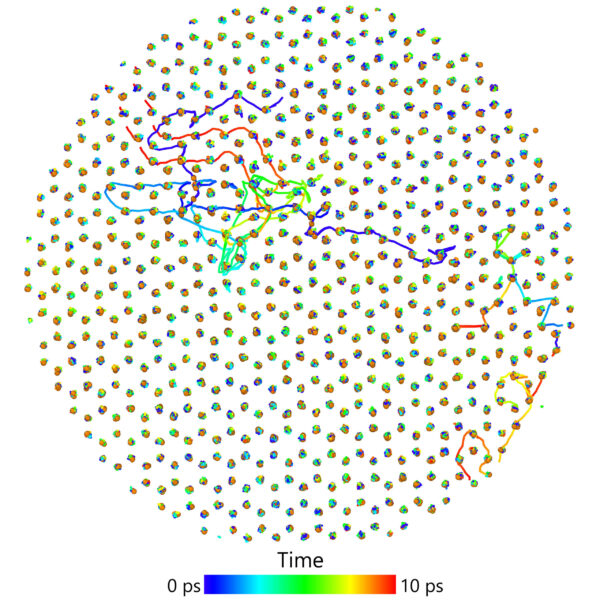2023-10-03 オークリッジ国立研究所(ORNL)
◆しかし、材料を延性化することでこれを克服できる可能性があります。また、陽極と固体電解質のインターフェースを機械的に安定させる必要があります。この研究は、バッテリー性能を向上させるための新しい材料設計への道を示しています。
<関連情報>
- https://www.ornl.gov/news/scientists-illuminate-mechanics-solid-state-batteries
- https://www.science.org/doi/10.1126/science.abg5998
固体電池: 力学の重要な役割 Solid-state batteries: The critical role of mechanics
Sergiy Kalnaus,Nancy J. Dudney,Andrew S. Westover,Erik Herbert, and Steve Hackney
Science Published: 22 Sep 2023
DOI:https://doi.org/10.1126/science.abg5998
Editor’s summary
Replacing a liquid electrolyte with a solid one has the potential to improve the capacity and safety of lithium metal batteries. Although the focus has been on the electrochemical behavior, internal stresses and strains can also substantially alter battery performance and lifetime. Kalnaus et al. reviewed our understanding of the mechanics of solid-state batteries and the effect of having multiple solid-solid interfaces. They also looked at ways to alleviate stresses through additional materials and designs to improve the lifetime and performance of these batteries. —Marc S. Lavine
Structured Abstract
BACKGROUND
Solid-state batteries (SSBs) have important potential advantages over traditional Li-ion batteries used in everyday phones and electric vehicles. Among these potential advantages is higher energy density and faster charging. A solid electrolyte separator may also provide a longer lifetime, wider operating temperature, and increased safety due to the absence of flammable organic solvents. One of the critical aspects of SSBs is the stress response of their microstructure to dimensional changes (strains) driven by mass transport. The compositional strains in cathode particles occur in liquid electrolyte batteries too, but in SSBs these strains lead to contact mechanics problems between expanding or contracting electrode particles and solid electrolyte. On the anode side, plating of lithium metal creates its own complex stress state at the interface with the solid electrolyte. A critical feature of SSBs is that such plating can occur not only at the electrode–electrolyte interface but within the solid electrolyte itself, inside its pores or along the grain boundaries. Such confined lithium deposition creates areas with high hydrostatic stress capable of initiating fractures in the electrolyte. Although the majority of failures in SSBs are driven by mechanics, most of the research has been dedicated to improving ion transport and electrochemical stability of electrolytes. As an attempt to bridge this gap, in this review we present a mechanics framework for SSBs and examine leading research in the field, focusing on the mechanisms by which stress is generated, prevented, and relieved.
ADVANCES
The push toward renewable resources requires the development of next-generation batteries with energy densities more than double that of current batteries and that can charge in 5 min or less. This has led to a race to develop electrolytes that can both facilitate 5-min fast charging and enable Li metal anodes—the key to high energy. The discovery of solid electrolytes that have high electrochemical stability with Li metal and sulfide solid electrolytes with ionic conductivities greater than those of any liquid electrolyte have spurred a shift in the research community toward SSBs. Although these discoveries have seeded the promise that SSBs can enable the vision of fast charging and a doubling of energy density, realization of this promise is feasible only if the mechanical behavior of battery materials is thoroughly understood and multiscale mechanics is integrated in the development of SSBs.
OUTLOOK
Several key challenges must be addressed, including (i) nonuniform lithium plating on a solid electrolyte surface and deposition of lithium metal within the solid electrolyte; (ii) loss of interfacial contact within the cell as a result of the volume changes associated with the electrochemical cycling that occurs at electrode contacts and also at grain boundaries; and (iii) manufacturing processes to form SSBs with a very thin solid electrolyte and a minimum of inactive components, including binders and structural supports. Mechanics is a common denominator connecting these problems. Deposition of metallic lithium into the surface and volume defects of a ceramic solid electrolyte results in local high stresses that can lead to electrolyte fracture with further propagation of metallic lithium into the cracks. In manufacturing, as a minimum requirement, the cathode–electrolyte stacks should possess enough strength to withstand the forces applied by the equipment. A better understanding of the mechanics of SSB materials will transfer to the development of solid electrolytes, cathodes, anodes, and cell architectures, as well as battery packs designed to manage the stresses of battery manufacturing and operation.
The promise of solid-state batteries.
SSBs offer a variety of multifunctional and safe solutions if important breakthroughs are made in engineering cell components and eliminating the need for tremendous external pressure to keep interfaces intact.
Abstract
Solid-state batteries with lithium metal anodes have the potential for higher energy density, longer lifetime, wider operating temperature, and increased safety. Although the bulk of the research has focused on improving transport kinetics and electrochemical stability of the materials and interfaces, there are also critical challenges that require investigation of the mechanics of materials. In batteries with solid-solid interfaces, mechanical contacts, and the development of stresses during operation of the solid-state batteries, become as critical as the electrochemical stability to keep steady charge transfer at these interfaces. This review will focus on stress and strain that result from normal and extended battery cycling and the associated mechanisms for stress relief, some of which lead to failure of these batteries.




